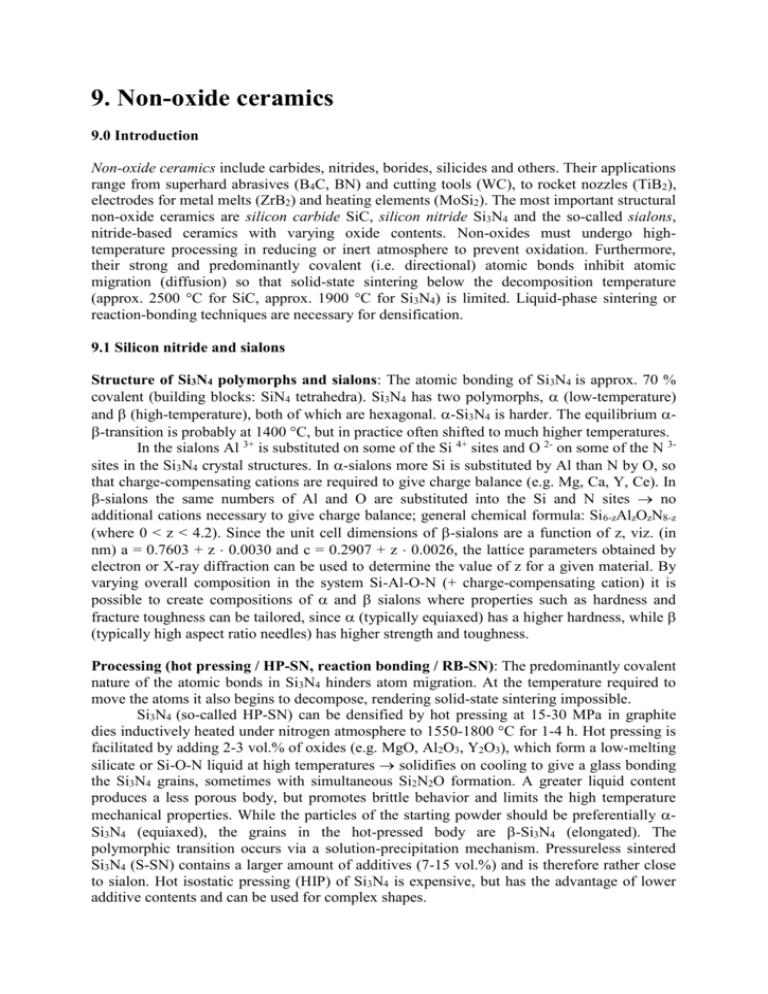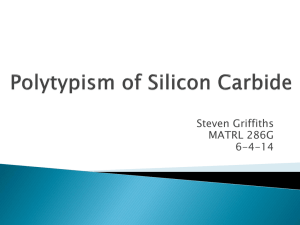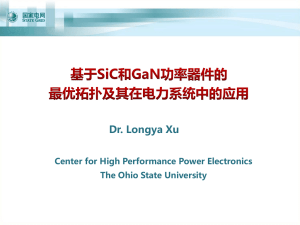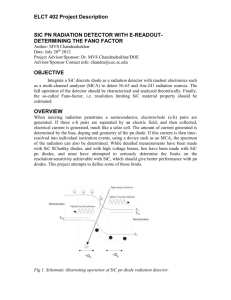melting decomposition
advertisement

9. Non-oxide ceramics 9.0 Introduction Non-oxide ceramics include carbides, nitrides, borides, silicides and others. Their applications range from superhard abrasives (B4C, BN) and cutting tools (WC), to rocket nozzles (TiB2), electrodes for metal melts (ZrB2) and heating elements (MoSi2). The most important structural non-oxide ceramics are silicon carbide SiC, silicon nitride Si3N4 and the so-called sialons, nitride-based ceramics with varying oxide contents. Non-oxides must undergo hightemperature processing in reducing or inert atmosphere to prevent oxidation. Furthermore, their strong and predominantly covalent (i.e. directional) atomic bonds inhibit atomic migration (diffusion) so that solid-state sintering below the decomposition temperature (approx. 2500 °C for SiC, approx. 1900 °C for Si3N4) is limited. Liquid-phase sintering or reaction-bonding techniques are necessary for densification. 9.1 Silicon nitride and sialons Structure of Si3N4 polymorphs and sialons: The atomic bonding of Si3N4 is approx. 70 % covalent (building blocks: SiN4 tetrahedra). Si3N4 has two polymorphs, (low-temperature) and (high-temperature), both of which are hexagonal. -Si3N4 is harder. The equilibrium -transition is probably at 1400 °C, but in practice often shifted to much higher temperatures. In the sialons Al 3+ is substituted on some of the Si 4+ sites and O 2- on some of the N 3sites in the Si3N4 crystal structures. In -sialons more Si is substituted by Al than N by O, so that charge-compensating cations are required to give charge balance (e.g. Mg, Ca, Y, Ce). In -sialons the same numbers of Al and O are substituted into the Si and N sites no additional cations necessary to give charge balance; general chemical formula: Si 6-zAlzOzN8-z (where 0 < z < 4.2). Since the unit cell dimensions of -sialons are a function of z, viz. (in nm) a = 0.7603 + z 0.0030 and c = 0.2907 + z 0.0026, the lattice parameters obtained by electron or X-ray diffraction can be used to determine the value of z for a given material. By varying overall composition in the system Si-Al-O-N (+ charge-compensating cation) it is possible to create compositions of and sialons where properties such as hardness and fracture toughness can be tailored, since (typically equiaxed) has a higher hardness, while (typically high aspect ratio needles) has higher strength and toughness. Processing (hot pressing / HP-SN, reaction bonding / RB-SN): The predominantly covalent nature of the atomic bonds in Si3N4 hinders atom migration. At the temperature required to move the atoms it also begins to decompose, rendering solid-state sintering impossible. Si3N4 (so-called HP-SN) can be densified by hot pressing at 15-30 MPa in graphite dies inductively heated under nitrogen atmosphere to 1550-1800 °C for 1-4 h. Hot pressing is facilitated by adding 2-3 vol.% of oxides (e.g. MgO, Al2O3, Y2O3), which form a low-melting silicate or Si-O-N liquid at high temperatures solidifies on cooling to give a glass bonding the Si3N4 grains, sometimes with simultaneous Si2N2O formation. A greater liquid content produces a less porous body, but promotes brittle behavior and limits the high temperature mechanical properties. While the particles of the starting powder should be preferentially Si3N4 (equiaxed), the grains in the hot-pressed body are -Si3N4 (elongated). The polymorphic transition occurs via a solution-precipitation mechanism. Pressureless sintered Si3N4 (S-SN) contains a larger amount of additives (7-15 vol.%) and is therefore rather close to sialon. Hot isostatic pressing (HIP) of Si3N4 is expensive, but has the advantage of lower additive contents and can be used for complex shapes. In the reaction bonding process a shaped Si powder compact is made (e.g. by pressing, slip casting or injection molding) and reacted in nitrogen (several days at 1250–1450 °C). The reaction 3 Si + 2 N2 Si3N4 is exothermic and must be carefully controlled (if allowed to proceed too quickly the Si would melt) almost pure Si3N4, but complete transformation of Si into Si3N4 is not achieved microstructure contains isolated Si particles in a continuous matrix of needle-like -Si3N4, more equiaxed -Si3N4 and residual porosity. Since the Si-toSi3N4 reaction is associated with a 22 % volume increase, the original pores in the Si compact are partially filled with the nitride phase shrinkage during nitridation very small ( nearnet-shape process). A post-sintering heat treatment at 1600-1800 °C (with MgO or Y2O3) can be applied to achieve high density, but this implies degradation of high-temperature properties. Alternatively, hot isostatic pressing can be applied. The vapor pressure of -sialon (solid solution) is lower than that of -Si3N4 (solvent) more liquid at lower temperature. Moreover, Al lowers the eutectic temperature. Control of the liquid volume allows the material to be densified by pressureless reaction sintering lower temperature inhibited grain growth small grain size, high strength. Sialons are more stable than -Si3N4 (lower vapor pressure reduces volatilization and decomposition). In contrast to Si3N4 there is a silica-rich liquid at 1800 °C (cf. the phase diagram Si3N4 – SiO2 – Al2O3 – AlN) in-situ liquid phase sintering aid without liquid-forming additives aim: formation of -sialons from powder mixes and densification via the high-temperature liquid; subsequent reactions should eliminate this liquid, finally leaving a purely crystalline material ( transient liquid phase sintering). Since sintering and reactions are slow, due to the high viscosity of the sialon liquid phase other oxides are added which form more fluid and reactive liquids Y2O3 (forms liquid at 1325 °C) promotes formation of -sialons and leaves residual glass, limiting the high-temperature properties. However, the glassy grain boundary phase (10-15 vol.% in reaction sintered sialons) can subsequently be crystallized e.g. to YAG (Y3Al5O12), again improving the high-temperature properties. Sialons can be made by reaction sintering (1750-1850 °C) or hot pressing (1500-1850 °C and 15-20 MPa) from Si3N4, Al2O3, AlN and Y2O3. During hot pressing sialons undergo a similar solutionprecipitation mechanism as Si3N4, so that -Si3N4 converts to elongated -sialon grains. Microstructure, properties and behavior: The elongated grains formed during hot pressing (“in-situ toughened Si3N4“) provide crack deflection, crack bridging and pullout behind the crack tip and so confer improved crack growth resistance (fracture toughness) on the material (Si3N4 ceramics are known for R-curve behavior, i.e. increasing crack growth resistance with increasing crack length). Ideally, small (for high strength) but high-aspectratio grains with a weak interface (for easier crack deflection) are desired in HP-SN. The grain boundary glass has a critical effect on high-temperature properties and typically starts to soften at about 1000 °C. Efforts are made to raise the softening point or enable crystallization to a more refractory phase such as Y2Si2O7 (1775 °C). In sialons YAG (yttrium aluminium garnet, 2110 °C) has a similar function. Mg-Si-O-N glasses are generally less viscous and have a lower softening temperature than Y-Si-O-N glasses. Hot pressing typically leaves < 2 % porosity so that high RT strengths result (400-1000 MPa), however only up to 1000 °C. In RB-SN, consisting predominantly of pure Si3N4 (with remnant Si and porosity) without sintering additives, strength and creep resistance are retained to rather high temperatures and the resistance to chemical attack is high (due to the absence of a grain boundary glass). All forms of RB-SN contain both (60-90 wt.%) and -Si3N4, being produced by nitriding below the melting point of Si (1410 °C), above. Typical properties of Si3N4: density 3.2 g/cm3, hardness 14-18 GPa, fracture toughness 2-8 MPam1/2, Young’s modulus 320 GPa, bend strength 400-1000 MPa, thermal expansion coefficient 2-310-6 K-1, thermal conductivity of order 50 W/mK; combination of low thermal expansion coefficient and high thermal conductivity excellent thermal shock resistance. -sialons have similar physical properties as Si3N4 but chemically some of the characteristics of alumina (improved chemical stability). Typical properties of sialons are: density 3.25 g/cm3, hardness 15-24 GPa, fracture toughness 4-8 MPam1/2, bend strength up to 1000 MPa, thermal expansion coefficient 310-6 K-1, thermal conductivity up to 10-50 W/mK. The strength of glass-containing sialons is high at room temperature but decreases as the intergranular glass softens above 1000 °C. YAG-bonded sialons have excellent oxidation resistance up to 1300 °C and good creep resistance and strength up to 1400 °C. -sialon is strong and tough up to 1350 °C, while -sialon has good hardness but slightly worse strength, toughness and oxidation resistance. With low values of z mechanical properties of -sialons become similar to those of -Si3N4, but hardness, fracture toughness and elastic modulus deteriorate with increasing z. Sialons with both phase (typically equiaxed) and phase (typically elongated) can be viewed as composites and the --ratio can be controlled to tailor properties. With increasing content hardness increases while fracture toughness decreases. Applications: Because of its high hardness and wear resistance Si3N4 is used in abrasives, grinding media, cutting tools, armouring and nozzles, because of its resistance to high temperatures and chemical attack in burners, welding nozzles, heat exchangers and as kiln furniture. In combination with low density and suitable electrical properties it is useful for engine parts (valves, turbocharger rotors, gas turbines, catalyst carriers, spark plugs). Finally, due to good thermal shock resistance it can be used for crucibles, thermocouple shielding tubes etc. Sialons have the additional advantages of higher toughness, improved chemical stability and sinterability. They are mainly used in applications requiring high wear resistance. 9.2 Silicon carbide SiC is the most widely used non-oxide ceramic material. It was first synthesized by Acheson in 1891 by heating a mixture of clay and carbon > 1600 °C in a carbon arc (“carborundum“, a name still used today for abrasive and refractory grade SiC). Most SiC (-SiC) is still synthesized via the Acheson process (carbothermal reaction of quartz). Only for SiC (-SiC) platelets or whiskers other processes are used, e.g. pyrolysis of rice hulls, spinning from organosilicon polymer precursors (e.g. “Nicalon“ or “Tyranno“ fibers), chemical vapor deposition (CVD) and the so-called vapor-liquid-solid (VLS) process, using liquid catalysts. Structure (polymorphs and polytypes): Due to the small electronegativity difference between C and Si predominantly covalent bond (88 %) strong, directional bonds, responsible for high decomposition temperature and hardness of SiC. SiC occurs in two general crystalline forms: cubic -SiC (low-temperature) and -SiC (high-temperature). The latter has a special type of one-dimensional polymorphism called polytypism (i.e. various stacking sequences in the c-direction) and can be cubic (zincblende structure) or hexagonal (wurtzite structure). Usually, -SiC is obtained by carbothermal reduction of quartz (Acheson process), while -SiC forms by direct reaction of Si and C (self-sustaining reaction), vapor phase routes and using plasma or laser heating. SiC powders always have an oxide coating (silica surface layer) particle size control is important (ultrafine powders have high oxygen impurity, similar to Si3N4). Graphitic carbon and silicon impurities influence processing and high-temperature behavior. A sufficient amount (but not too much) of carbon must be present to react with the surface oxide and allow good sinterability. Processing routes (reaction bonding / RB-SiC, pressureless sintering / S-SiC): Reactionbonded SiC (RB-SiC) is formed by bonding SiC and C powder with further SiC produced in situ by chemical reaction between Si liquid or vapor and C (e.g. graphite flakes and polymer binder). The -SiC powder compacts can be shaped e.g. by plastic forming (extrusion or injection molding) and subsequently heated to remove the binder and pyrolyze the polymer. The resulting porous compact is then infiltrated with Si and heated in a RF radio frequency furnace at temperatures > 1500 °C under vacuum or inert atmosphere. Liquid Si penetrates the porous body by capillary action. Processing can be controlled to give relatively pure, but porous, SiC or a dense microstructure with 10-40 vol.% free Si in a SiC matrix. In the latter case the weak SiC-Si boundaries control the mechanical strength, which is 350-550 MPa at room temperature but exhibits a steep decrease at 1400 °C, the softening point of Si. Until the 1970s it was widely assumed that due to its strong, covalent bonding ( high activation energy for diffusion) SiC could not be pressureless sintered (hot-pressed SiC / HP-SiC had previously been made via liquid-phase sintering at 30-40 MPa and 1900-2000 °C by adding MgO or Al2O3, today 0.5-3 % of B, C, Al, AlN, Al4C3, WC, BN or B4C). However, Prochazka showed in 1973 that submicron SiC powder (-SiC made by vapor phase routes) could be densified in inert gas or vacuum atmosphere at 19502100 °C with small additions of B and C without added pressure. Later the same was done with Acheson -SiC powders. Thus, a low-cost route was available to pressureless or self-sintered SiC (S-SiC), a strong material which retained its strength at high temperatures (due to the absence of the weakening grain boundary phase). This ceramic also exhibits excellent corrosion resistance both to acid and alkaline media and contains no free carbon or graphite. The roles of B and C in pressureless sintering of SiC are not fully understood (solid state sintering mechanism). Singly doped (Al or B) -SiC powders excessive grain growth low strength (large anisometric grains acting as flaws), while double doping (Al and B) leads to homogeneous, fine-grained microstructures. When -SiC starting powders are used, coarsening (and excessive grain growth) is associated with the transformation from - to SiC (small grains tend to be , large ). Excessive grain growth and transformation can be prevented by annealing (1650-1850 °C, 1 h). S-SiC is not liable to corrosive attack (as would be the case for RB-SiC, due to the presence of Si as a second phase). Microstructure, properties and behavior: Fine-grained microstructures with isometric grains are desired in SiC best mechanical properties. Typical properties of SiC: density 3.2 g/cm3, hardness 21-25 GPa, fracture toughness 3-6 MPam1/2, Young’s modulus 420 GPa, bend strength 450-650 MPa, thermal expansion coefficient 4-510-6 K-1, thermal conductivity of order 50 W/mK. The creep resistance of SiC is higher than that of Si3N4 (in the sequence SSiC > RB-SiC > RB-SN > Sialons > Y2O3-HP-SN > MgO-HP-SN), due to different creep mechanisms. In general SiC has a better oxidation resistance than Si3N4 ( less strength degradation). Among common ceramics SiC is the best absorber of microwave energy and can therefore be used to promote microwave heating and sintering of Al2O3–SiC composites. Applications: High hardness extensive use of (low-grade) SiC as abrasives and in grinding wheels. SiC is also used as a refractory (high thermal conductivity, high decomposition temperature, chemical inertness, low wettability by molten metals and slags), heating element (appropriate electrical properties) and high-temperature semiconductor (only ultra-pure, doped SiC), as well as a structural material in contact with corrosive liquids such as concentrated HF and NaOH (due to its excellent corrosion resistance) and in heat engine components (due to its excellent wear resistance; its low coefficient of friction reduces wear in contact with itself or other materials). Table 1. Approximate melting or decomposition temperatures and densities of some carbides and nitrides. Carbide HfC TaC ZrC TiC ThC Al4C3 B4C MoC WC SiC Melting temperature [°C] 3887 – 3890 3875 – 3880 3530 3250 2625 2800 2450 – 2720 (in reducing atmosphere) 2692 2630 – 2870 2300 – 2700 (decomposition in open or closed systems) Density [g/cm3] 12.2 14.5 6.7 4.7 10.7 3.0 2.5 Nitride 8.4 15.6 3.2 (lowtemperature -phase cubic at 2100 °C hightemperature -phase) VN HfN TaN ZrN TiN ThN AlN BN Si3N4 Melting temperature [°C] 3310 3100 2980 2950 2630 2400 3000 (in reducing atmosphere) 2030 Density [g/cm3] 14.0 14.1 7.3 4.0 11.5 3.1 2.25 (hex.) 3.45 (cub.) 1900 (decomposition in reducing atmosphere) 3.2 (lowtemperature -phase hex. at 1400– 1550 °C hightemperature -phase hex.) 6.0 Table 2. Approximate melting or decomposition temperatures and densities of some borides and silicides. Boride HfB2 ZrB2 TaB2 TiB2 Melting temperature [°C] 3250 3200 3050 2950 Density [g/cm3] 6.1 11.2 4.5 Silicide HfSi ZrSi2 TaSi2 MoSi2 Melting temperature [°C] 2100 2100 2100 2047 Density [g/cm3] 4.9 6.3





